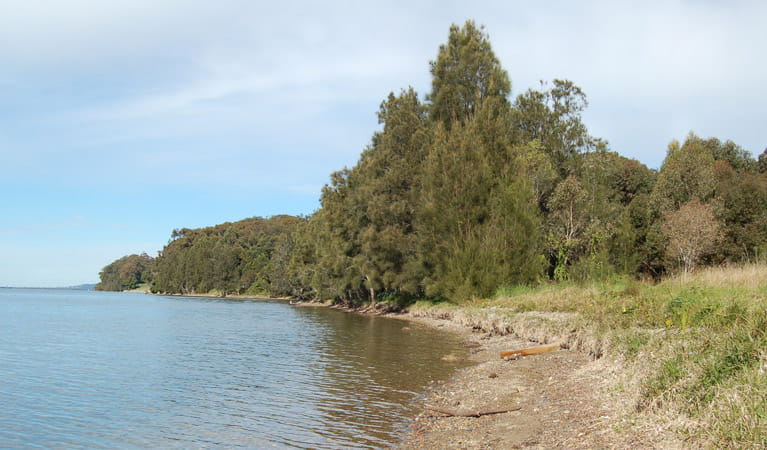Awaba Bay bush regeneration
Lake Macquarie State Conservation Area
Overview
Are you interested in restoring bushland and habitats for local plants and wildlife? Volunteer for this great bush regeneration activity in Lake Macquarie State Conservation Area, near Newcastle.
- Work
- Bush regeneration, weed and pest management
- When
1st Sunday of the month.
- Grade
- Medium. You’ll be weeding and doing physical work. Medium level of fitness required.
Do you like visiting national parks and reserves because of the variety of plants and wildlife? Are you a keen gardener, or want to know more about gardening? If so, this activity could be for you.
You’ll be removing weeds, rubbish and doing some minor walking track and trail maintenance. The Awaba Bay bush regeneration group has made a real contribution to the health of this reserve, which has minimal weed invasion because of our volunteers’ work.
This bush regeneration work protects the habitat of the powerful owl. It also encourages the growth of black-eyed Susans, and benefits the overall coastal wetland environment that you’ll be working in. Awaba Bay is a beautiful part of Lake Macquarie, with scenic lake views and a lovely breeze off the water on a warm day.
You’ll be working with like-minded people, engaging with your local community, learning about and helping to protect your local environment. It’s great if you have some gardening knowledge. Even if you don’t, all you need is a desire to learn, because either the group’s convenor or a NSW National Parks staff member will give volunteers training for this activity.
It’s a good idea to wear closed-in shoes and long-sleeved clothing. Bring a hat, sunscreen, a raincoat, snacks, lunch, drinking water and gardening gloves. Tools and hard hat supplied.
Find out more about volunteering with us
Local alerts
For the latest updates on fires, closures and other alerts in this area, see https://www.nationalparks.nsw.gov.au/things-to-do/volunteer-activities/awaba-bay-bush-regeneration/local-alerts
Park info
- in Lake Macquarie State Conservation Area in the Sydney and surrounds and North Coast regions
Lake Macquarie State Conservation Area is always open but may have to close at times due to extreme weather or fire danger.
Visitor info
All the practical information you need to know about Awaba Bay bush regeneration .
Getting there and parking
Get driving directions
For Bolton Point (Awaba Bay):
- Take the Cessnock Road exit off the F3 towards Awaba and Toronto
- Continue along the road as it becomes Awaba Road
- Turn left at Carey Street in Toronto to cross the water
- Turn right along Bay Road, which loops around the point to Lake Macquarie State Conservation Area.
Parking
Street parking is available.
Maps and downloads
Learn more
Awaba Bay bush regeneration is in Lake Macquarie State Conservation Area. Here are just some of the reasons why this park is special:
Activities galore

Whatever pace you like to take life at, there's stacks to do on Lake Macquarie. Kayak the serene waters, meander along Awaba Bay Foreshore walk or try Wangi circuit walking track for a gorgeous helping of nature. Picnic at Alexanders, throw a line over your boat, or take things a little bit faster with some waterskiing.
- Alexanders picnic area This very peaceful picnic area with scenic views, at the southern end of Awaba Bay Foreshore walk is the perfect spot to rest after a bushwalk along beautiful Lake Macquarie - indulge in birdwatching, picnicking, and relaxing among the diverse habitats.
- Marmong picnic area Marmong picnic area is an idyllic place to picnic by the lake, with opportunities for walking, swimming, boating, paddlnig, fishing and birdwatching within Lake Macquarie State Conservation Area.
- Wangi circuit walking track Take a peaceful bushwalk through towering forests to the shores of Lake Macquarie on Wangi circuit walking track, with wonderful scenic views of Pulbah Island, birdwatching and picnicking opportunities, and even sea turtles to see.
An important place

The plentiful nature and beauty of this area have made it a special place for thousands of years. The Awabakal Aboriginal people were the original inhabitants, enjoying plant foods such as cabbage palm and lillypilly, and shellfish like pipis, cockles, mussels, whelks, and oysters collected from rock platforms, the lake's foreshore, and beaches. Local people caught fish with lines or spears, or trapped them in weirs built at the entrance of tidal channels. The beautiful Pulbah Island is considered sacred by the Awabakal People.
Holidaying history

The special atmosphere of Lake Macquarie has long drawn holidaymakers. A ferry service between Wangi Wangi Point and Toronto led to a growth in tourism in the 1910s and 1920s, and a number of swimming enclosures and guesthouses catered for the area's many visitors. Miners came to Wangi Wangi Point from the Cessnock coalfields, and it became a tent city during December and January when the mines closed for Christmas. You can still stay at Wangi Wangi Point in the Tourist Park.
Wonderful wildlife, diverse habitats

The animals love it here too, making their home among the diverse habitats. Green sea turtles, dolphins, sugar and squirrel gliders, and kangaroos all call the park their home. If you look up, you'll find sea eagles, kookaburras, lorikeets, and the threatened pied oystercatcher in the trees and sky above the lake. On bushwalks, look out for lovely orchids, spectacular wattles, and coastal banksia.
- Alexanders picnic area This very peaceful picnic area with scenic views, at the southern end of Awaba Bay Foreshore walk is the perfect spot to rest after a bushwalk along beautiful Lake Macquarie - indulge in birdwatching, picnicking, and relaxing among the diverse habitats.
- Awaba Bay Foreshore walk Take a stroll along the shores of Lake Macquarie on Awaba Bay Foreshore walk, enjoying the spectacular scenic lake views while birdwatching and keeping an eye out for dolphins and green sea turtles.
- Lake Macquarie cruise and guided nature walk Jump aboard CoastXP’s adventure boat for an exciting, all-inclusive cruise and guided nature walk at Lake Macquarie State Conservation Area.

